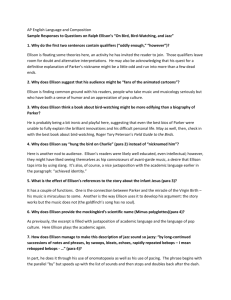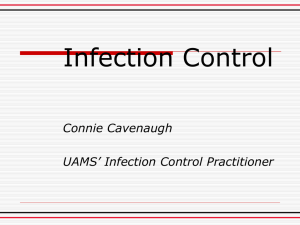Herpes Simplex Encephalitis - University of Oklahoma Health
advertisement
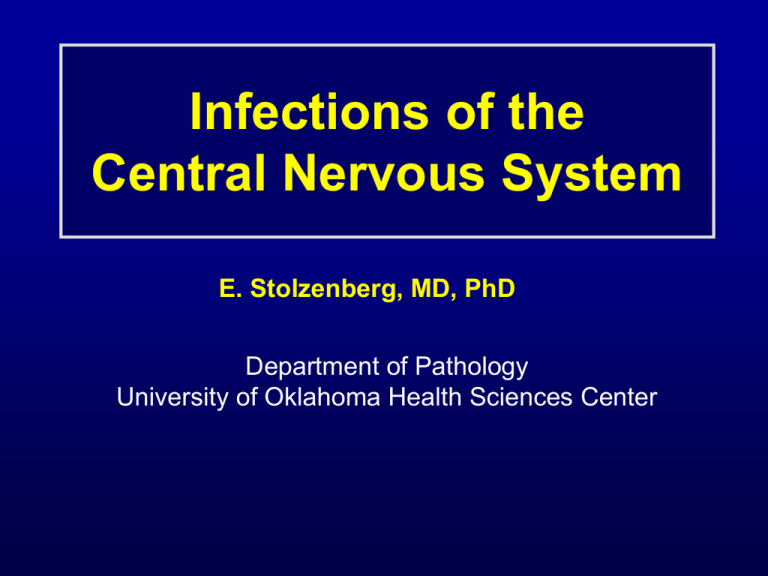
Infections of the Central Nervous System E. Stolzenberg, MD, PhD Department of Pathology University of Oklahoma Health Sciences Center Objectives • Describe the microscopic and macroscopic features of acute bacterial meningitis. • Recognize the complications of bacterial meningitis. • Identify the characteristics of tertiary syphilis. • Name the common causes of fugal meningitis. • Recognize the histopathologic features of herpes encephalitis. Parameters of CNS Infection Infectious agents: Bacteria, fungus, virus, protozoa, metazoa, prion. Mechanism: Acute, chronic, mixed, suppurative, abscess, granulomatous. Tissue involvement: Meningitis, meningoencephalitis, encephalitis, ventriculitis, etc. Distribution: Panencephalitis, rhombenencephalitis, poliomyelitis, etc. Route of entry: Blood, local infection, penetrating, contaminated surgical procedures (eg. VP-shunt), etc. Miscellaneous: Age, local factors, environmental factors, underlying compromised immune system, cardiac abnormalies, race and ethnic group, etc. Basic Pathologic Patterns in CNS Infection Meningitis Meningoencephalitis Encephalitis, Myelitis, Encephalomyelitis Choroid plexitis Subdural empyema and epidural abscess Cerebritis Ventriculitis and ependymitis Brain abscess Infectious Agents of the CNS Bacteria: Pneumococcal meningitis, tuberculoma, neurosyphilis, etc. Fungus: Aspergillus abscess, cryptococcal meningitis, etc. Virus: Herpes simplex encephalitis, poliomyelitis, etc. Protozoa: Primary amoebic meningoencephalitis, toxoplasmosis, malarial encephalitis, etc. Metazoa: Cysticercosis, schistosomiasis, etc. Prion: Creutzfeldt-Jakob disease, Kuru, Fatal familial insomnia, etc. Acute Bacterial Infections Bacterial Infections Acute meningitis Cerebritis Granulomatous meningitis and granuloma Ventriculitis and ependymitis Brain abscess Subdural empyema and epidural abscess Changes associated with spirochetal infections Acute bacterial Meningitis Definition: An acute inflammatory process that is limited to the meninges and subarachnoid space. Epidemiology: • About 25,000 cases/year in the U.S. • Over 70% occur in children under 5 years-old. • Mortality without antibiotics: 90-100% • Mortality with antibiotic treatment: 5-15%. • Morbidity: 43%. Pathology of Acute Bacterial Meningitis Macroscopic: • Cerebral edema and congested leptomeninges. • Thrombosis, hemorrhagic infarctions. • Purulent exudate in the subarachnoid space. Microscopic: • Polymorphonuclear leukocytes infiltrating the leptomeninges, subarachnoid space and ventricles. • Angiitis and thrombosis. • Necrotic debris and macrophages. • Fibrotic scarring of the leptomeninges. Bacterial Meningitis Grahams and Lantos, 2002 Ellison D et al., 1998 Esiri and Oppenheimer, 1989 Complications of Acute Bacterial Meningitis • Cerebral edema leading to increased intracranial pressure, herniation and compromised cerebral blood supply. • Cerebritis. • Arterial and venous infarction of the brain. • Mycotic aneurysm. • Hydrocephalus, due to scarring of the arachnoid granulations. Complications of Bacterial Infections Thrombosed vessel Hemorrhagic Ventriculitis Grahams and Lantos, 2002 Ellison D et al., 1998 Petechial hemorrhage in meningococcemia Infarct Ellison D et al., 1998 Grahams Scheld WM et al., 1997 Brain Abscess Definition: A localized suppurative infection within the brain parenchyma. Pathogenesis: • About 50% of the cases are due to localized spread of a septic focus in the paranasal sinuses, middle ear, or dental infection. • About 25% of the cases are secondary to hematogenous spread from an infectious source outside the head. Example: congenital heart disease with right-to-left shunt. • The rest are due to trauma and miscellaneous etiology such as compromised immunity such as transplantation. • Bacterial profile is related to the route of spread and include Streptococcus milleri, anaerobic bacteria, Actinomyces israelii and others. Bacterial Infection: Pyogenic Abscess Ellison D et al., 1998 Syphilis • • • • Treponema pallidum Primary syphilis – localized disease Secondary syphilis – systemic disease Tertiary syphilis – Chronic granulomas – Aortitis – Neurosyphilis, tabes dorsalis • dementia, confusion, irritability, headache, tremors, incontinence • Abnormal gait, sensory ataxia (degeneration of dorsal columns and dorsal roots) – Argyll Robertson pupil – pupils accommodate but don’t react to light • Dx: VDRL, FTA-ABS • Rx: penicillin G Fungal Infection Fungal Infections of the CNS General: They can occur as fungal meningitis or space occupying lesions such as abscess or solid inflammatory mass. Shape of the fungus: The pathology is often related to the shape of the fungus. Fungi that exist only as yeast form in human body often cause meningitis, those with filamentous form often cause infarction and abscess, those that can exist as both forms can cause both. Epidemiology: Some species are more common than the other and the incidence is geographically related. Predisposing factors: Unlike bacterial infections that predisposing factors play a relatively minor role, predisposing factors and underlying systemic disorders play a major role. Particularly, patients are not always immunocompromised. Organism Incidenc e Predilection Meningitis Abscess or Infl. mass Infarct Cryptococcus +++ ++++ ++++ + + Coccidiodes +++ ++++ ++++ + + Candida +++ ++ ++ ++ - Aspergillus ++ ++ + +++ ++++ Zygomycetes ++ ++ + +++ ++++ Histoplasma ++ + + + + Blastomyces ++ + + + - Sporothrix ++ + + - - Paracoccidioides + ± + ± - Dermatiaceous spp + +++ ± ++++ - Pseudoallescheria + + ++ ++ - Grahams Scheld WM et al., 1997 • • • • Crytococcus neoformans and gattii Heavily encapsulated yeast Found in soil, pigeon droppings Opportunistic infection: AIDS and immunosuppressed patients (including long-term corticosteroid use) • Diagnosis: – Detection of cryptococcal antigen (capsular material) by culture of CSF, sputum, urine – India ink: poor sensitivity Cryptococal meningitis Ellison D et al., 1998 Klingsberg et al., 2001 • Aspergillus fumigatus • Mold with septate hyphae that branches at acute angles • Immunocompromised host, chronic granulomatous disease • Rare cause of fungal meningitis Aspergillosis Ellison D et al., 1998 • Mucor and Rhizopus spp. • Mold with irregular nonseptate hyphae branching at angles >90 degrees • Ketoacidotic diabetes and leukemia patients • Rhinocerebral, frontal lobe abscesses • Fungi proliferate in blood vessel walls, enter the brain through cribiform plate • Headache, facial pain, black necrotic eschar on face Zygomycosis (Mucormycosis) Grahams Scheld WM et al., 1997 Viral Infections Shared Aspects of Viral Infections General: Many of them occur as viral meningitis or meningoencephalitis, a few (such as herpes simplex encephalitis) manifest as a necrotizing mass-like lesion. Direct cytotoxic effects vs. necrosis and inflammation. Distribution: Different viruses, often but not always, have a predilection on different parts of the nervous system. Reactivation: Reactivation of an indolent or subclinical infection occurs in some viruses such as herpes simplex virus and JC virus. CSF: There is usually marked elevation of lymphocytes without reduction in glucose level. Detection: The viral genome are often detectable by molecular techniques such as in situ hybridization (on tissue) and PCR (on tissue and CSF). Immunostaining is also useful. Shared Pathologic Aspects of Viral Infections Perivascular lymphocytic infiltration- the extent of inflammation may vary greatly. Microglial formation and reactive gliosis. Necrosis- usually occur as a later event than inflammation. CMV Inclusion- It can be nuclear or cytoplasmic. Demyelination is associated with some viral infections such as HIV encephalopathy and progressive multifocal leukoencephalopathy (PML). Rabies Ellison D et al., 1998 Acute Viral Infection Herpes Simplex Encephalitis Ellison D et al., 1998 Herpes Simplex Encephalitis Ellison D et al., 1998 Herpes Simplex Encephalitis Characteristics: The only common form of encephalitis that can occur around the year. Typically presents as space occupying lesion in the temporal lobe. Pathogen: Herpes simplex virus, usually type I. Routes of entry and pathogenesis: • Primary mucocutaneous infection. • Establishment of latency in trigeminal ganglion or dorsal root ganglion and reactivation of virus. • Olfactory bulb. Herpes Simplex Encephalitis • Characteristic widespread, bilateral but asymmetrical involvement. Necrosis, particularly in the temporal lobe and the hippocampus. • Cingulate gyrus may also be involved. The brain stem is rarely involved. Ellison D et al., 1998 Herpes Simplex Encephalitis EM Necrosis In situ hybridization Ellison D et al., 1998 Subacute or Chronic Viral Infection Subacute and Chronic Viral Infections General: They tend to progress slowly over months or years rather than weeks or days. The incubation period is often longer. Reactivation of a latent infection in an immunocompromised host is responsible in some of them. Virus type Disease Measle virus Subacute sclerosing panencephalitis Measle virus Measle inclusion body encephalitis Rubella virus Progressive rubella panencephalitis JC virus Progressive multifocal leukoencephalopathy (PML) HIV HIV encephalitis, vacuolar myelopathy, etc. . Microglial nodule Human Immunodeficiency Virus (HIV) Multinucleated giant cells Calcification Ellison D et al., 1998

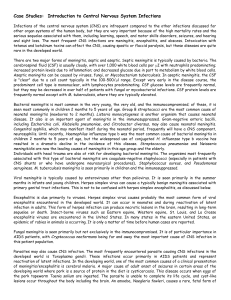
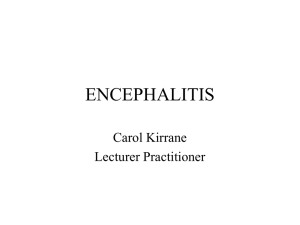

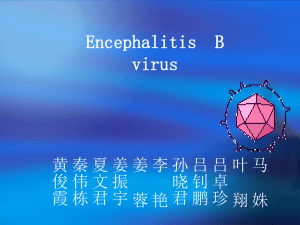

![MENINGITIS[2]](http://s2.studylib.net/store/data/005749244_1-0310b36bca6c7b9165194f04ae7a6bf6-300x300.png)

